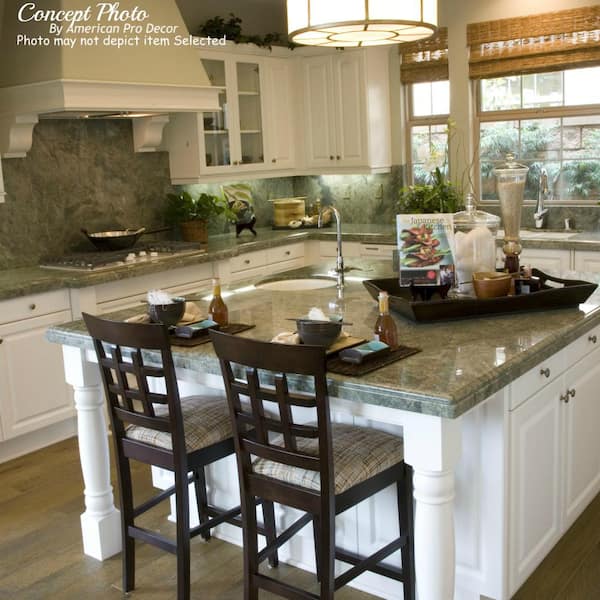Find Long Lasting and Ornamental Legs For Kitchen Island Transformations
Necessary Variables to Think About When Picking Legs For Cooking Area Island
Picking the suitable legs for a cooking area island involves a mindful assessment of several factors that can considerably influence both capability and visual charm. As we discover these aspects, it comes to be clear that each choice can have far-ranging implications for the total cooking area experience.
Material Options
When choosing legs for a cooking area island, understanding the different product alternatives is important for accomplishing both visual allure and structural stability (Legs For Kitchen Island). The option of material dramatically affects not only the sturdiness of the island however additionally its total design and functionality
Metal legs, typically made from stainless steel or wrought iron, add a commercial and modern-day feeling while making sure toughness and stability. These materials are immune to use and can support substantial weight, making them perfect for larger islands.
An additional alternative is crafted materials, like MDF or plywood, which can be a lot more economical while still using a variety of finishes. They might not supply the exact same degree of security as solid timber or metal. Legs For Kitchen Island. Materials such as acrylic or glass can develop a modern look, though they might require added support to make sure stability.
Inevitably, the selection of product for kitchen area island legs should line up with the preferred performance and the total style of the kitchen.
Design And Style

When considering design, the form and coating of the legs are critical. Tapered legs can provide a sense of agility and beauty, while thicker, a lot more robust legs can convey strength and stability. Additionally, the coating-- be it repainted, discolored, or natural-- need to enhance the kitchen cabinetry and kitchen counter materials to create a unified appearance.
In addition, the layout of the legs can likewise show individual preference. Customized or decorative legs, such as those including detailed makings or distinct geometric shapes, can offer as prime focus, adding character and personality to the kitchen. Ultimately, the appropriate choice will not just enhance capability but likewise elevate the aesthetic appeal, making the kitchen area island a standout function of the home.
Height Factors To Consider
Selecting the suitable elevation for kitchen island legs is vital, as it directly influences both functionality and convenience. The conventional height for a kitchen island normally ranges from 36 to 42 inches, straightening with usual countertop elevations.

It is also vital to make up users' elevations and preferences. Customizing the height can guarantee a comfy experience for all family members, making the kitchen island an extra satisfying and functional room.
Weight Support
Guaranteeing appropriate weight support for kitchen area island legs is important for both security and performance. The cooking area island often offers numerous purposes, including food preparation, dining, and added storage space, requiring a durable support framework. When choosing legs, it is important to consider the general weight capability called for based upon the island's planned use and the materials that will certainly be placed on it.
The option of product for the legs plays a significant function in their weight-bearing capacities. Solid timber, metal, and durable compounds normally give remarkable toughness compared to lighter materials. Furthermore, the design of the legs-- whether they are straight, tapered, or have a pedestal form-- can affect their capability to distribute weight successfully across the framework.
Constantly speak with the maker's specs concerning load limitations to ensure that the legs can maintain the designated weight without endangering security. In summary, choosing kitchen area island legs with adequate weight support is important for developing a practical and secure cooking area.
Installment and Upkeep
Proper installation and maintenance of kitchen island legs are crucial for making certain durability and security. To begin, it is vital to comply with the manufacturer's guidelines during setup. This often involves safeguarding the legs to the island base making use of proper bolts, guaranteeing that the legs are level and lined up. Using a level device can help avoid wobbling and improve the general aesthetic allure of the kitchen island.
As soon as mounted, regular upkeep is needed to preserve the integrity and appearance of the legs - Legs For Kitchen Island. For wood legs, periodic cleansing with a damp cloth and application of ideal wood gloss can avoid wetness damages and keep their coating. Metal legs may require a mild cleaning remedy to remove oil and crud, adhered to by a completely dry fabric to stop corrosion development
Furthermore, examine the legs regularly for indicators of wear or damages, such as cracks or loosened joints. Tightening her explanation screws or bolts as required can also prolong the life-span of the legs. By sticking to these setup and maintenance methods, property owners can guarantee that their kitchen area island continues to be strong and visually appealing for many years to find.
Conclusion

Aesthetic comprehensibility is extremely important in selecting the design and layout of legs for a kitchen island, as these components significantly affect the general ambiance of the area. Tapered legs can give a sense of agility and sophistication, while read the article thicker, more durable legs can communicate stamina and stability.Selecting the proper elevation for kitchen area island legs is important, as it directly influences both performance and comfort. In recap, choosing kitchen area island legs with ample weight support is important for developing a functional and safe cooking room.
In verdict, selecting legs for a kitchen area island demands mindful consideration of various variables, consisting of product choices, style, elevation, weight support, and setup.